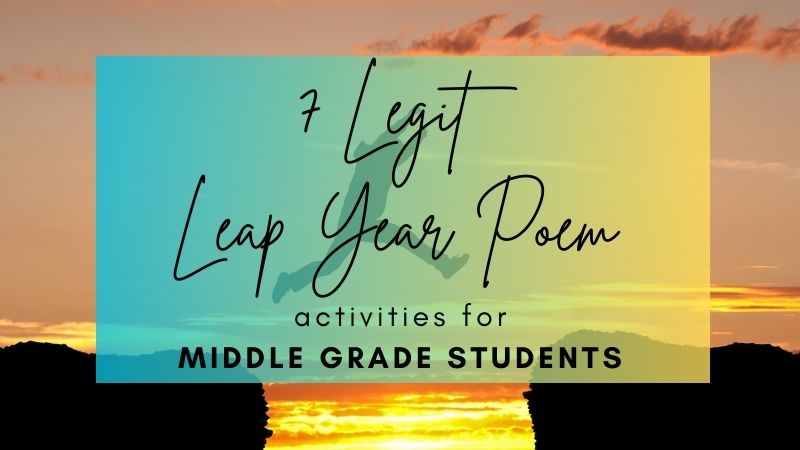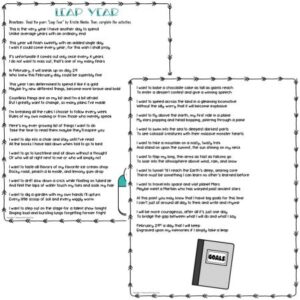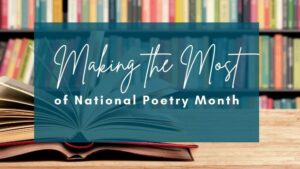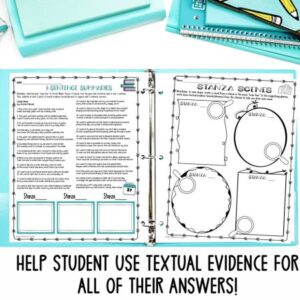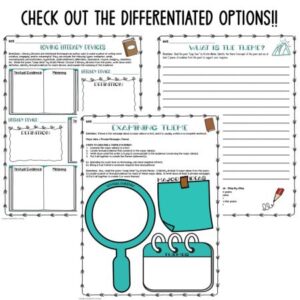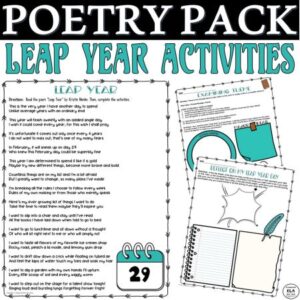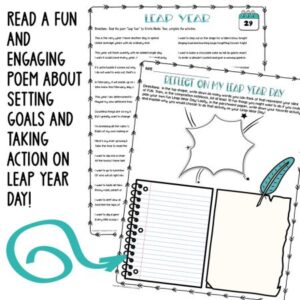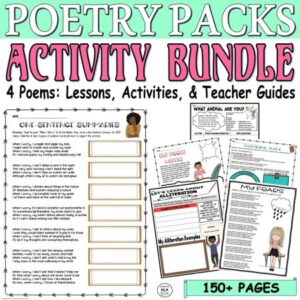I don’t know about you, but I love random holidays and events! I mean, it seems there is a day to celebrate everything from bagels to rainbows to curly-haired puppy dogs. And Leap Year or Leap Day is a time we celebrate only every 4 years! I guess that’s why I had to write a Leap Year Poem!
Every four years, we get an additional day in our regular 365-day year, so why not make this Leap Year and Leap Year Day on February 29th FUN and ENGAGING by incorporating a Leap Year Poem?
I hope you enjoy this Leap Year Poem and standards-aligned activities that will get your students thinking about and analyzing poetry!
Need help with Test Prep? Check out this FREE Pack of 3 Test Prep Activities to help students achieve success on standardized tests!

Leap Year Poem
Leap Year
by Kristin Menke
This is the very year I have another day to spend
Unlike average years with an ordinary end
This year will finish sweetly with an added single day
I wish it could come every year; for this wish I shall pray
It’s unfortunate it comes out only once every 4 years
I do not want to miss out; that’s one of my many fears
In February, it will sneak up on day 29
Who knew this February day could be superbly fine
This year I am determined to spend it like it is gold
Maybe try new different things, become more brave and bold
Countless things are on my list and I’m a bit afraid
But I greatly want to change, so many plans I’ve made
I’m breaking all the rules I choose to follow every week
Rules of my own making or from those who merely speak
Here’s my ever growing list of things I want to do
Take the time to read them maybe they’ll inspire you
I want to slip into a chair and stay until I’ve read
All the books I have laid down when told to go to bed
I want to go to lunchtime and sit down without a thought
Of who will sit right next to me or who will simply not
I want to taste all flavors of my favorite ice cream shop
Rocky road, peach a la mode, and lemony gum drop
I want to drift slow down a crick while floating on tubed air
And feel the laps of water touch my toes and soak my hair
I want to dig a garden with my own hands I’ll upturn
Every little scoop of soil and every wiggly worm
I want to step out on the stage for a talent show tonight
Singing loud and bursting lungs forgetting former fright
I want to bake a chocolate cake as tall as giants reach
To enter a dessert contest and give a winning speech
I want to speed across the land in a gleaming locomotive
Without the silly worry that it will become explosive
I want to fly above the earth, my first ride in a plane
My ears popping and head bopping, peering through a pane
I want to swim into the sea to deepest darkest parts
To see colossal creatures with their massive monster hearts
I want to hike a mountain on a misty, twisty trek
And stand on upon the summit, the sun shining on my neck
I want to flap my long, thin arms as fast as falcons go
To soar into the atmosphere above wind, rain, and snow
I want to tunnel ‘til I reach the Earth’s deep, searing core
There must be something I can learn no other’s learned before
I want to travel into space and visit planet Mars
Maybe meet a Martian who has warped past ancient stars
At this point you may know that I have big goals for this time
I can’t just sit around all day to think and write and rhyme
I will be more courageous, after all it’s just one day
To bridge the gap between what I will do and what I say
February 29th a day that I will keep
Engraved upon my memories if I simply take a leap
Want some fun ideas for National Poetry Month? Click to read!
7 Legit Leap Year Poem Activities

#1 SUMMARIZE IN 1-SENTENCE:
Writing summaries can be made much easier when we limit students to only one sentence. In a single sentence, we as teachers can usually tell if a student has understood what he or she has read. So why not select certain stanzas or allow students to choose specific stanzas from the Leap Year Poem, locate textual evidence, and create a 1-sentence summary?
Directions: Read the poem “Leap Year” by Kristin Menke. Choose 10 stanzas from the poem and summarize each in only 1 sentence. Then, provide at least 2 pieces of textual evidence (words/phrases) to support each 1-sentence summary.
Here is an example!
| Stanza | Textual evidence | Summary |
| 1 This is the very year I have another day to spend
Unlike average years with an ordinary end |
Ex. “year”
Ex. “another day to spend” Ex. “unlike average years” |
Ex. The speaker introduces the idea that this year is different from other years because of an additional day. |
Make your Leap Year Day EASY and STRESS-FREE by getting readymade poetry activities!
If you need differentiated options, CLICK HERE!
#2 VISUALIZE SCENES:
Visualization is such a great technique in helping students to comprehend poetry more deeply. Being able to visualize by reading a detailed description is vital to understanding the most important parts of any text; however, visualization is even more necessary when it comes to poetry.
Yes, we listen to songs, which I would argue is a form of poetry. Unfortunately, without the melody and rhythm, it can be difficult to grasp a poem’s meaning in this day and age.
Instead, we can help our students by assigning a visualization activity for this Leap Year Poem. Who doesn’t like to draw or color once in a while?
Activity: Reread the Leap Year Poem by Kristin Menke. Use textual evidence from the stanzas to draw various scenes.
Easy-peasy!
Click HERE for a DONE FOR YOU Leap Year Poetry Pack!
#3 EXAMINE THEME:
Before you begin reading the Leap Year Poem, you might want to introduce the concept of theme!
Definition: Theme is the message about a major idea in a text, and it is usually written in a complete sentence.
Major Idea + Phrase Message = Theme
STEPS TO CREATING A THEME STATEMENT:
- Examine the major idea(s) in a text.
- Locate textual evidence that connects to the major idea(s).
- Write down what the writer is trying to communicate to the audience concerning the major idea(s).
- Put it all together to create the theme statement(s).
Ex. Spending too much time on technology can have negative effects.
Ex. Being a true friend to someone requires time and patience.
You could encourage students to create their own theme statements based on Kristin Menke’s Leap Year Poem!
#4 WRITE SHORT RESPONSES:
After your students read the Leap Year Poem, you can help your students with writing about the theme! If they have already examined the poem by pinpointing major ideas, it will make the writing process for this Leap Year Poem that MUCH easier.
Writing Prompt Idea: What is the theme of the Leap Year Poem by Kristin Menke? Use at least 2 pieces of textual evidence to support your ideas.
Make sure to include a step-by-step outline if your students need help with developing their ideas. Additionally, teaching with a rubric for this poem will help your students in the writing process!
#5 LEARN ABOUT LITERARY DEVICES
Literary Devices are intentional techniques an author uses to make a piece of writing more creative, engaging, and/or meaningful! They can include the following types: metaphor, simile, onomatopoeia, personification, hyperbole, understatement, alliteration, assonance, rhyme, imagery, repetition, etc.
Student Directions-Read the poem “Leap Year” by Kristin Menke. Choose 3 literary devices from the poem, write down the definition, identify textual evidence for each device, and explain the meaning of the evidence.
Want EASY-TO-TEACH Leap Year Poem Activities? Click HERE!
#6 REFLECT IN PERSONAL WRITING
When students read and then write, they comprehend; however, they can learn even more when they PERSONALLY connect to what they are reading and writing!
WRITING IDEAS-
- Describe your perfect Leap Year Day.
- Create a list of fun Leap Year Day activities.
- Write your own poem about Leap Day.
- Create an advertisement for a Leap Year Movie.
- Develop a skit involving Leap Year Day.
When students write, they remember!
#7 ENVISION A LEAP YEAR DAY
As we are still near the start of the year, why not have students envision a year full of possibilities? There is still time!
Students can illustrate their goals, dreams, and adventures that could all be achieved this Leap Year or on Leap Day!
WHY READ A LEAP YEAR POEM AND TEACH LEAP YEAR ACTIVITIES?
Well, why not incorporate a bit of Leap Year Poem fun when you get the chance? Students love to read poetry that relates to them in some way. And let’s be real, we are all amazed when Leap Year just shows up randomly…well, every four years.
Click here to JOIN my email list for more reading comprehension ideas and to download “13 Effective Ways To Integrate Test Prep Into Your Classroom!”
This Poetry Month Poem Analysis Activities and Lesson BUNDLE incorporates the Common Core standards and contains FUN and ENGAGING poetry analysis activities for these 4 poems: “When I Worry,” “My Fears,” “Leap Year,” and “Unique Unicorn!” Make National Poetry Month relevant to your 4th, 5th, and 6th grade students with these varied reading and writing organizers!
Want help with teaching this Leap Year Poem with relevant Leap Year Activities? Check out my store, Kristin Menke-Integrated ELA Test Prep!

